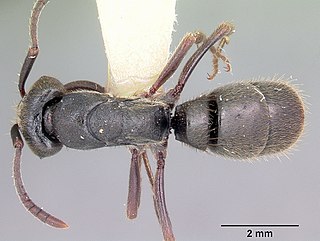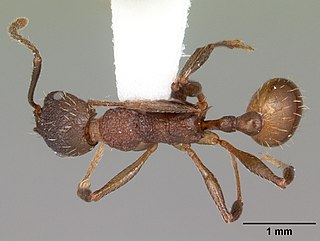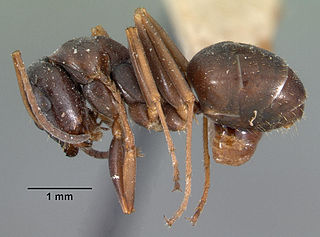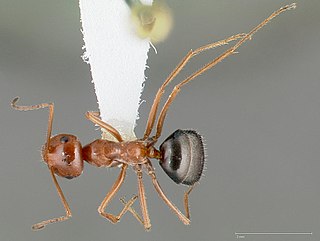
Honey ants, also called honeypot ants, are ants which have specialized workers that are gorged with food by workers to the point that their abdomens swell enormously. Other ants then extract nourishment from them, through the process of trophallaxis. They function as living larders. Honeypot ants belong to any of several genera, including Myrmecocystus and Camponotus. They were first documented in 1881 by Henry C. McCook, and described further in 1908 by William Morton Wheeler.
Roy R. Snelling was an internationally renowned American entomologist who studied Hymenoptera, mainly ants, wasps and bees. He was the emeritus collections manager at the Natural History Museum of Los Angeles County where he worked for over 30 years, joining the museum in 1963 and retiring in 1993. He dedicated his professional life to making insect biodiversity better known and appreciated.

Myrmecocystus is a North American genus of ants in the subfamily Formicinae. It is one of five genera that includes honeypot ants. Worker ants keep and tend plerergates, which are other ants that store large quantities of nutritious fluid in their abdomens to feed the colony during famine times.. Some species engage in highly territorial tournaments, which can result in intraspecific slavery. During the raids, they carry off larvae, workers, and plerergates.

Myrmecocystus mimicus is a North American species of ant in the genus Myrmecocystus. The species is widely distributed, from Kansas south to Texas and Mexico, and west to California.

Pachycondyla harpax, the rapacious panther ant, is a species of ant in the family Formicidae.

Pogonomyrmex comanche, the Comanche harvester ant, is a species of ant in the family Formicidae.

Aphaenogaster mariae is a species of ant in the family Formicidae.
Acmaeodera wheeleri is a species of metallic wood-boring beetle in the family Buprestidae. It is found in Central America and North America.

Lasiini is a tribe of ants in the family Formicidae. There are about 10 genera and more than 450 described species in Lasiini.

Myrmecocystus placodops is a species of ant in the family Formicidae.

Formica subaenescens is a species of ant in the family Formicidae.

Hypoponera opacior, the ponerine ant, is a species of ant in the family Formicidae.

Formica podzolica is a species of ant in the family Formicidae.
Prokoenenia wheeleri is a species of microscorpion in the family Prokoeneniidae.
Camponotus tortuganus is a species of ant in the family Formicidae.

Myrmecocystus kennedyi is a species of ant in the family Formicidae.
Myrmecocystus mendax is a species of ant in the family Formicidae.

Myrmecocystus semirufus is a species of ant in the family Formicidae.

Cyphomyrmex wheeleri, the fungus gardening ant, is a species of higher myrmicine in the family Formicidae.

Myrmecocystus yuma is a species of ant native to the southwestern United States and a small part of Northern Mexico. This species, like most in the genus of Myrmecocystus, create worker repletes.














